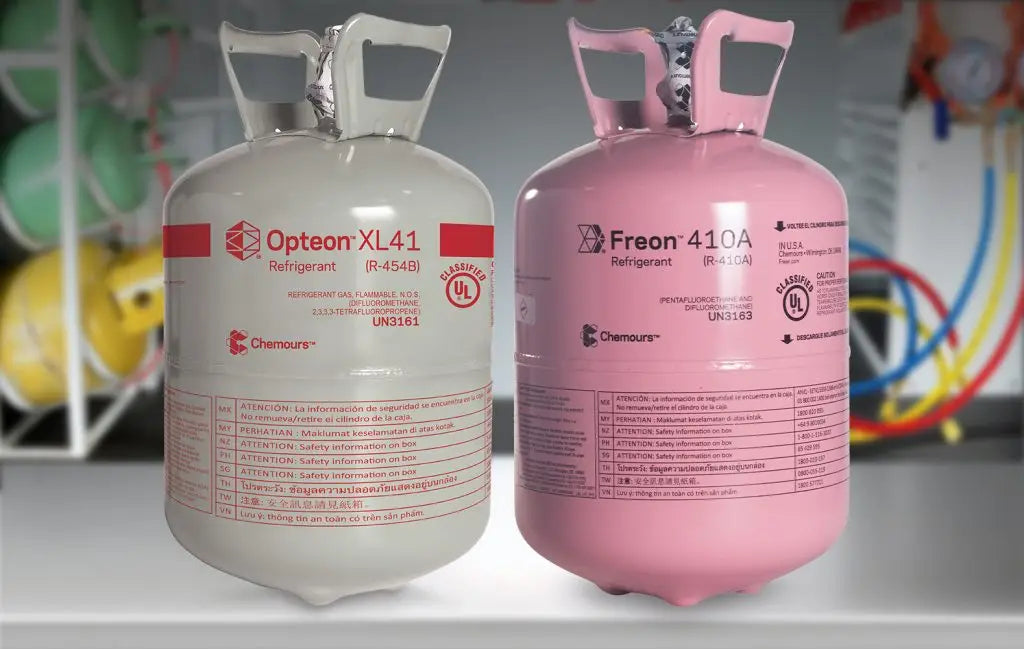As HVAC regulations continue to push for environmentally friendly solutions, A2L refrigerants have become the new standard. Two of the most widely adopted low-GWP options in 2025 are R-32 and R-454B. If you're shopping for a new air conditioner or furnace, understanding the differences between these refrigerants can help you make a smarter, future-proof choice.
In this article, we’ll compare R-32 vs. R-454B in terms of efficiency, cost, safety, and long-term maintenance to help you choose the best option for your home.
🌱 What Are A2L Refrigerants?
A2L refrigerants are classified as mildly flammable and low-GWP alternatives to legacy refrigerants like R-410A. They are part of a broader global initiative to reduce the environmental impact of air conditioning systems.
Both R-32 and R-454B fall into the A2L category and are approved for residential use under EPA SNAP rules. They help manufacturers meet HFC phasedown targets outlined by the American Innovation and Manufacturing Act (AIM Act).
⚙️ Refrigerant Comparison: R-32 vs. R-454B
| Feature | R-32 | R-454B |
|---|---|---|
| Type | Single-component | Blend (68.9% R-32, 31.1% R-1234yf) |
| Global Warming Potential (GWP) | 675 | 466 |
| Cooling Efficiency | Higher | Moderate |
| Flammability | Mild (A2L) | Mild (A2L) |
| Serviceability | Easier (pure refrigerant) | More complex (blend) |
| Cost | Lower | Higher |
| Component Separation Risk | None | Moderate |
🔋 Efficiency and Performance
R-32 has higher thermodynamic efficiency than R-454B, which means systems using R-32 often consume less electricity and offer faster cooling. It also supports smaller coil designs, which can reduce equipment size.
According to Daikin, R-32 systems offer up to 10% more efficiency than R-410A, and similar gains compared to R-454B.
🔧 Installation and Service Considerations
Because R-32 is a single-component refrigerant, it is easier for technicians to handle, reclaim, and recharge. With R-454B, being a blend, the refrigerant must be charged as a liquid to maintain its component ratio.
This adds a layer of complexity during servicing, and improper handling can reduce system efficiency or require a full refrigerant replacement, increasing service costs.
HVAC School offers an excellent breakdown of handling precautions for both refrigerants.
💰 Cost Comparison
R-32-based systems are generally cheaper both upfront and over the lifespan of the unit.
-
R-32 equipment is more widely available globally, benefiting from economies of scale.
-
Technicians already trained on R-410A find it easier to switch to R-32, keeping labor costs manageable.
In contrast, R-454B systems:
-
Require specialized tools
-
Have fewer certified technicians available
-
Are harder to source parts for in some regions
🔥 Safety and Regulatory Status
While both R-32 and R-454B are A2L refrigerants and share similar safety classifications, real-world handling differs.
-
R-32 has been used in over 160 million units worldwide with a proven safety record, according to EIA International
-
R-454B is newer and has less field data available
Both refrigerants must follow safety codes and often require enhanced ventilation, spark-free tools, and fire safety permitting in some jurisdictions.
Learn more from the U.S. Department of Energy’s refrigerant transition resource.
🏠 Which Refrigerant Should Homeowners Choose?
Choose R-32 If You:
-
Want higher energy efficiency
-
Prefer simpler service and lower maintenance costs
-
Seek broad compatibility with global OEM brands
Choose R-454B If You:
-
Live in an area where it’s mandated by building codes
-
Want the lowest possible GWP for environmental reasons
-
Are working with a contractor certified in blend refrigerants
✅ Final Recommendation
For most homeowners, R-32 represents the best balance of efficiency, serviceability, and cost. Its growing adoption worldwide means more units, more technicians, and better parts availability.
Still unsure? Read our comprehensive R-32 vs. R-454B pillar guide to help finalize your HVAC purchase.







